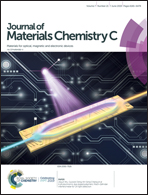A tungsten oxide–lutetium bisphthalocyanine n–p–n heterojunction: from nanomaterials to a new transducer for chemo-sensing†
Abstract
We report on a new hybrid heterojunction gas-sensitive device by combining a molecular material with a metal oxide. WO3 was synthesised via an aerosol-assisted chemical vapour deposition technique from a tungsten hexacarbonyl precursor. Onto an inorganic film, LuPc2 was vacuum evaporated. The morphology of the WO3–LuPc2 hybrid films is dominated by the morphological features of the tungsten oxide film, as shown by scanning electron microscopy and atomic force microscopy. Raman spectroscopy of the device confirms the presence of both materials. The non-linear I–V characteristics demonstrate the existence of an energy barrier at the interface between the inorganic and molecular materials. The interfacial phenomenon was confirmed by means of impedance spectroscopy. Finally, the positive response to ammonia confirms the n-type nature of the charge carriers responsible for the transport properties through the device, in accordance with the n-type conductivity of WO3. This response is fully reversible whatever the relative humidity value in the range 10–70% rh. Even though the current is shifted when the relative humidity decreases, ammonia sensitivity remains almost unchanged (2.5 nA ppm−1) for rh ranging from 30 to 50%. It is worth noting that the present device operates at room temperature with excellent reversibility and stability, showing the lowest limit of detection for ammonia ever reported for this device architecture (250 ppb).



 Please wait while we load your content...
Please wait while we load your content...